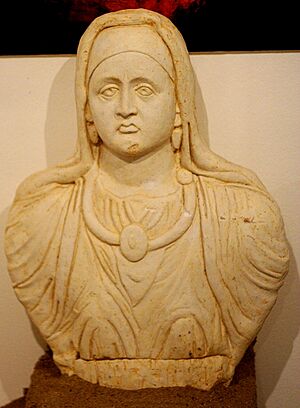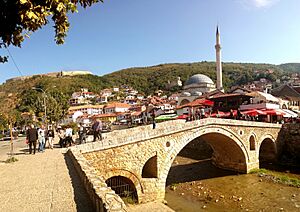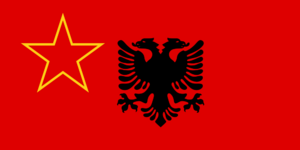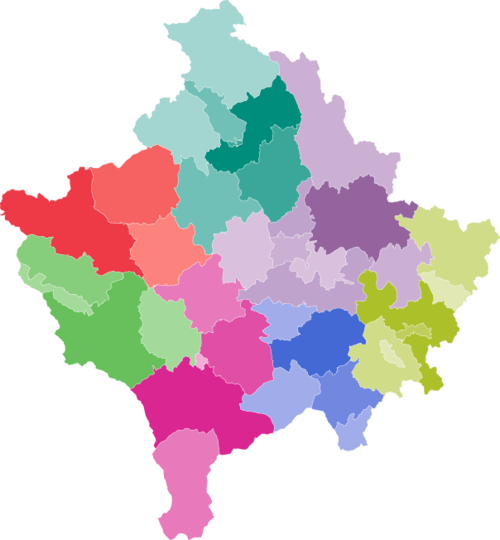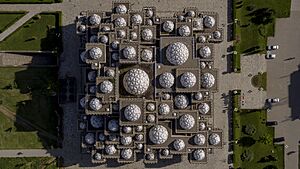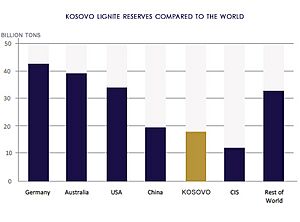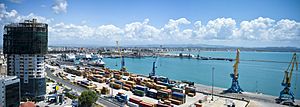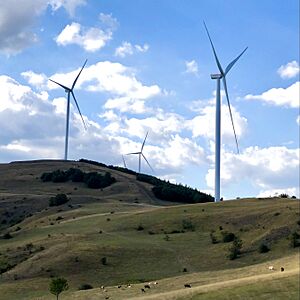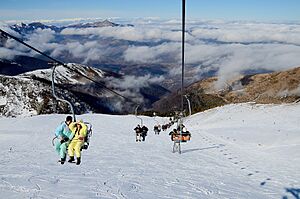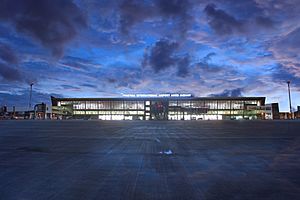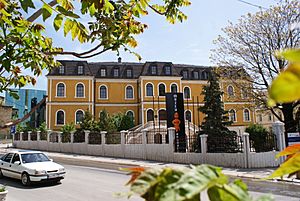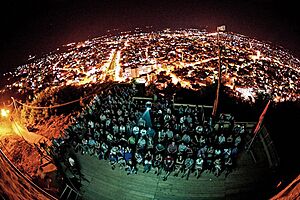Kosovo facts for kids
Quick facts for kids
Republic of Kosovo
|
|
|---|---|
|
|
|
|
Anthem: Himni i Republikës së Kosovës
"Anthem of the Republic of Kosovo" |
|
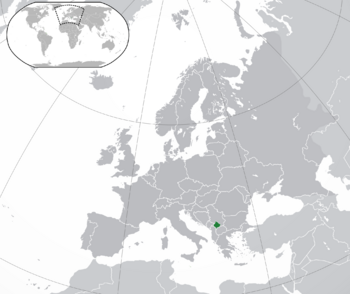
Location of Kosovo (green)
in Europe (dark grey) |
|
| Status | Independent, claimed by Serbia |
| Capital and largest city
|
Pristinaa 42°40′N 21°10′E / 42.667°N 21.167°E |
| Official languages | Albanian Serbian |
| Regional languages | |
| Ethnic groups
(2024)
|
|
| Religion
(2024)
|
|
| Demonym(s) |
|
| Government | Unitary parliamentary republic |
| Vjosa Osmani | |
| Albin Kurti | |
|
• Speaker of the Assembly
|
Dimal Basha |
| Legislature | Assembly |
| Establishment | |
|
• Sanjak of Prizren
|
1455 |
|
• Kosovo Vilayet
|
1877 |
| 1913 | |
|
• Autonomous Province within Yugoslavia
|
31 January 1946 |
|
• Republic of Kosova
|
2 July 1990 |
|
• Kumanovo Agreement
|
9 June 1999 |
|
• UN Administration
|
10 June 1999 |
| 17 February 2008 | |
|
• End of Steering Group supervision
|
10 September 2012 |
|
• Brussels Agreement
|
19 April 2013 |
| Area | |
|
• Total
|
10,887 km2 (4,203 sq mi) |
|
• Water (%)
|
1.0 |
| Population | |
|
• 2024 census
|
|
|
• Density
|
146/km2 (378.1/sq mi) |
| GDP (PPP) | 2024 estimate |
|
• Total
|
|
|
• Per capita
|
|
| GDP (nominal) | 2024 estimate |
|
• Total
|
|
|
• Per capita
|
|
| Gini (2017) | ▲ 29.0 low |
| HDI (2021) | high |
| Currency | Euro (€)b (EUR) |
| Time zone | UTC+1 (CET) |
|
• Summer (DST)
|
UTC+2 (CEST) |
| Date format | dd.mm.yyyy |
| Driving side | right |
| Calling code | +383 |
| ISO 3166 code | XK |
| Internet TLD | .xkc (proposed) |
|
|
Kosovo, officially known as the Republic of Kosovo, is a country in Southeast Europe. It is a landlocked country, meaning it has no direct access to the sea. Kosovo shares borders with Albania to the southwest, Montenegro to the west, Serbia to the north and east, and North Macedonia to the southeast.
The country covers an area of about 10,887 square kilometers and has a population of nearly 1.6 million people. Most of the people living in Kosovo are ethnic Albanians, making up about 92% of the population. Kosovo has diverse landscapes, including high plains, rolling hills, and impressive mountains, some reaching over 2,500 meters high.
Kosovo's climate is mostly continental, with influences from the Mediterranean and alpine regions. The capital and largest city is Pristina. Other important cities include Prizren, Ferizaj, Gjilan, and Peja.
Kosovo has a rich history, dating back to ancient times. It declared its independence from Serbia on February 17, 2008. Since then, many countries around the world have recognized Kosovo as an independent state. It is working to build its economy and strengthen its place in the international community.
Contents
Understanding the Name of Kosovo
How Kosovo Got Its Name
The name Kosovo comes from a South Slavic language. It means 'Blackbird Field' in Serbian, referring to a famous field where the Battle of Kosovo took place in 1389. This name was first used for a larger area when the Ottoman Vilayet of Kosovo was created in 1877.
Different Names for Regions
In the past, the western part of Kosovo was known as Metohija. This was because many lands there were owned by Serbian Orthodox monasteries. Today, the entire country is usually called Kosovo in English. In Albanian, it is called Kosova.
Ancient Names and Modern Identity
Some Albanians also like to call Kosovo Dardania. This was the name of an ancient kingdom and later a Roman province that covered the area of modern Kosovo. The name comes from the ancient tribe called the Dardani. The former Kosovo President Ibrahim Rugova supported this "Dardanian" identity. The flag of Dardania is still used as the official Presidential seal and standard.
A Journey Through Kosovo's History
Ancient Times in Kosovo
Kosovo's location and rich natural resources made it a great place for people to live a long time ago. Hundreds of archaeological sites show this. The earliest signs of people living here date back to the Stone Age.

The first organized settlements found in Kosovo belong to the Neolithic Starčevo and Vinča cultures. Places like Vlashnjë and Runik are important Neolithic sites. An ancient musical instrument, an ocarina made of baked clay, was found in Runik. It is the first musical instrument recorded in Kosovo.
The Dardani were a very important ancient tribe in the Kosovo region. A large area, including Kosovo, was named Dardania after them.
Roman Period in Kosovo
During Roman rule, Kosovo was part of two provinces. The city of Ulpiana, near modern-day Gračanica, was very important. It became a Roman city in the 2nd century AD. Emperor Justinian I rebuilt it after an earthquake and renamed it Iustinianna Secunda.
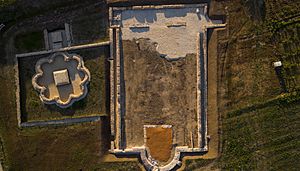
Other towns like Vendenis and Municipium Dardanorum also grew during this time. Many settlements were near mines or major roads. People in the region became Christian during Roman rule.
Kosovo in the Middle Ages
For many centuries, Kosovo was a border area. It was part of the Roman Empire and later the Byzantine Empire. Control of the region changed often. In the 13th century, Kosovo became a key part of the Serbian medieval state. The Serbian Patriarchate was established here.
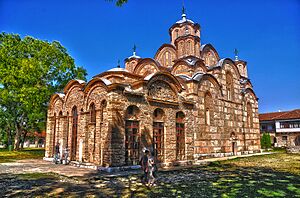
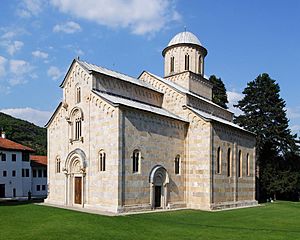
During the 13th and 14th centuries, Kosovo was a center for politics, culture, and religion in the Serbian Kingdom. Many Christian monasteries and forts were built. The Medieval Monuments in Kosovo are a UNESCO World Heritage Site. They include four Serbian Orthodox churches and monasteries.
Ottoman Rule in Kosovo
The Ottoman Empire expanded into the Balkans in the late 14th and 15th centuries. The Battle of Kosovo in 1389 was a very important event. Ottoman forces fought against a coalition led by Prince Lazar. The Ottomans fully conquered Kosovo after the Second Battle of Kosovo. They ruled for almost 500 years until 1912.
During this long period, Islam was introduced to the region. Kosovo was also a center for the Albanian Renaissance. This was a time when Albanian culture and identity became stronger.
The Rise of Nationalism
In the 19th century, people across the Balkans started to feel a stronger sense of ethnic nationalism. In 1878, the League of Prizren was formed in Kosovo. This group wanted to unite all Albanians in the Ottoman Empire and gain more rights. Their goals sometimes conflicted with those of the Serbs.
After the Balkan Wars (1912–1913), Kosovo was divided between the Kingdom of Serbia and the Kingdom of Montenegro. Many Albanians left Kosovo during this time.
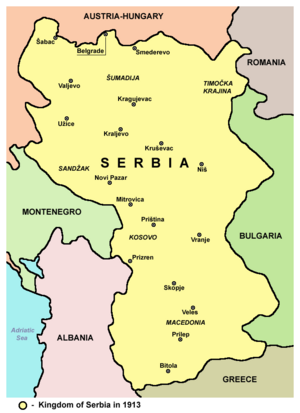
World Wars and Yugoslavia
During World War I, Kosovo was occupied by Bulgaria and Austria-Hungary. After the war, it became part of the Kingdom of Yugoslavia. The government tried to encourage Serbs to settle in Kosovo. Education in the Albanian language was not allowed for a time.
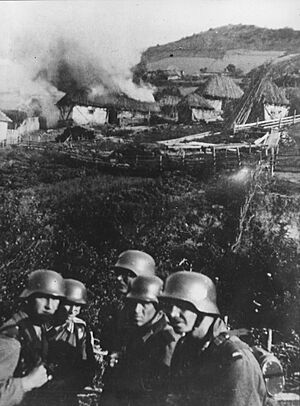
After World War II, most of Kosovo became part of Italian-controlled Albania. Later, it became an Autonomous Province within Yugoslavia.
Communist Yugoslavia Era
Kosovo became the Autonomous Region of Kosovo and Metohija in 1945. There were often tensions between ethnic Albanians and the Yugoslav government. Albanians sought more rights and greater autonomy.
In the late 1960s, Kosovo gained more self-rule. The University of Pristina was created as an Albanian language institution. By 1974, Kosovo had significant autonomy, with its own government and parliament.

However, tensions continued. In 1981, protests by Albanians seeking more rights were put down. Some rights were then taken away, like Albanian language textbooks in schools.
The Kosovo War and Its Aftermath
Tensions grew worse in Kosovo during the 1980s. In 1989, Serbian President Slobodan Milošević reduced Kosovo's special self-governing status. This led to a non-violent movement by Kosovar Albanians who wanted independence. They created their own schools and healthcare systems.

In 1990, Kosovar Albanians declared the Republic of Kosova. In 1992, Ibrahim Rugova was elected its president. Only Albania officially recognized this republic. By the mid-1990s, people became impatient. The Kosovo Liberation Army (KLA) began to launch attacks. This led to the Kosovo War in 1998 and 1999.
International pressure grew, and NATO intervened in 1999. This led to the withdrawal of Yugoslav forces from Kosovo. Many people had to leave their homes during the conflict. After the war, the United Nations Interim Administration Mission in Kosovo (UNMIK) was established. Kosovo Force (KFOR), a NATO-led peacekeeping force, also arrived to help maintain peace.
Kosovo's Declaration of Independence
Kosovo officially declared its independence from Serbia on February 17, 2008. Many countries around the world have recognized its independence. Kosovo has joined international organizations like the International Monetary Fund and World Bank.
Serbia does not officially recognize Kosovo as a separate state. However, it accepts the authority of Kosovo's institutions as part of the Brussels Agreement from 2013. This agreement helped improve relations between the two sides. In 2023, leaders from Kosovo and Serbia agreed on steps to normalize their relationship. This included recognizing each other's documents like passports and license plates.
Exploring Kosovo's Geography
Land and Mountains

Kosovo is located in the center of Southeast Europe. Its borders are mostly surrounded by mountains. The most famous mountain ranges are the Accursed Mountains in the west and the Šar Mountains in the southeast. These mountains offer stunning views and natural beauty.
Between the mountains, Kosovo has two main plains: the Kosovo Plain in the east and the Metohija Plain in the west.
Rivers and Lakes
Kosovo has several rivers and lakes. The longest river is the White Drin. Other important rivers include the Sitnica, Lepenc, Ibar, and Llapi. The Nerodime River is special because it splits and flows into two different seas: the Black Sea and the Aegean Sea.
The largest lakes are Batllava, Badovc, Gazivoda, and Radoniq.
Kosovo's Climate
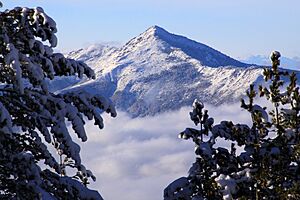
Most of Kosovo has a Continental climate, with influences from the Mediterranean and Alpine regions. This means it has warm summers and cold winters. The mountainous areas are colder, with an Alpine climate. The southern areas are warmer, with a Mediterranean climate.
The average temperature in Kosovo is about 9.5°C (49°F). July is the warmest month, and January is the coldest.
Plants and Animals of Kosovo
Kosovo is rich in biodiversity. Forests cover about 39% of the country. It has over 1,800 different kinds of plants. This is a large number for a small country!
The mountains in the west and southeast are home to many rare animals. These include brown bears, lynxes, wild cats, wolves, and foxes. Many types of birds, like the golden eagle, also live here. Kosovo has two national parks, Bjeshkët e Nemuna National Park and Sharr Mountains National Park, to protect its nature.
Environmental Challenges
Kosovo faces environmental challenges like air and water pollution. It is also working on waste management and protecting its natural areas. The country is taking steps to reduce greenhouse gas emissions and achieve carbon neutrality by 2050.
Government and Politics in Kosovo
Kosovo is a parliamentary republic. This means its government is chosen by the people through elections. The government has three main parts: the legislative (which makes laws), the executive (which carries out laws), and the judicial (which interprets laws).
The President is the head of state. The president represents the country and is elected every five years. The Prime Minister is the head of government. The prime minister leads the government and is chosen by the parliament.
Like many countries, Kosovo faces challenges in ensuring fair governance and fighting against dishonest practices.
Foreign Relations
Kosovo has diplomatic relations with many countries around the world. As of 2023, 104 out of 193 United Nations member states recognize Kosovo's independence. It is also a member of several international organizations.
Relations with Albania are very special because both countries share the same language and culture. The Albanian language is one of Kosovo's official languages.
Kosovo's Military and Security
The Kosovo Security Force (KSF) is Kosovo's national security force. Its job is to protect the country's borders and the safety of its people. The president of Kosovo is the commander-in-chief.
The Kosovo Force (KFOR) is a NATO-led international peacekeeping force. KFOR came to Kosovo in 1999 to help keep the peace. Camp Bondsteel is a large KFOR base in Kosovo. In 2018, Kosovo passed laws to change the KSF into a full army.
Laws and Justice
Kosovo's legal system is based on civil law. It has courts for civil and criminal cases, and a Constitutional Court. The Kosovo Police is the main law enforcement agency.
In 2023, Kosovo was ranked among the top ten countries globally for personal safety and effective law enforcement.
Administrative Divisions
Kosovo is divided into seven districts. These districts are further divided into 38 municipalities. The largest district is the District of Pristina, where the capital city of Pristina is located.
|
People and Culture of Kosovo
Population and Diversity
According to the 2024 census, Kosovo's population is about 1,585,566. The average life expectancy is about 79.68 years. Kosovo is home to many different communities. The largest group is Albanians, making up about 92% of the population. Other groups include Serbs, Bosniaks, Ashkali and Balkan Egyptians, and Turks.
Ensuring everyone has equal opportunities and feels included is an ongoing effort. In 2024, Kosovo ranked 29th in the World Happiness Report, showing a good level of happiness among its citizens.
Languages Spoken
Albanian and Serbian are the official languages in Kosovo. Albanian is spoken by most of the population. Other languages like Turkish, Bosnian, and Romani are also official in some municipalities. This helps protect the rights of people who speak minority languages.
Religions in Kosovo
| Religion in Kosovo | ||||
|---|---|---|---|---|
| Muslim | 93.5% | |||
| Christian | 4.1% | |||
| – Eastern Orthodox | 2.3% | |||
| – Roman Catholic | 1.8% | |||
| Other | 0.5% | |||
| Non-religious | 0.5% | |||
| Undeclared | 1.5% | |||
Kosovo is a secular state, meaning it has no official religion. People are free to believe and practice any religion they choose. Most people in Kosovo are Sunni Muslims (93.5%). There are also Christians, including Eastern Orthodox (2.3%) and Roman Catholics (1.8%).
Education for All
Education in Kosovo is mostly public and supported by the state. It includes preschool, primary, secondary, and higher education. Primary and secondary education is required for everyone. Classes are taught in Albanian, Serbian, Bosnian, Turkish, and Croatian.
Students can go to universities and other higher-education institutes. They can earn Bachelor's, Master's, and PhD degrees.
Healthcare Services
Kosovo has a healthcare system with primary, secondary, and tertiary care. Primary care is provided in family medicine centers. Secondary care is available in regional hospitals. The University Clinical Center of Kosovo offers specialized health services. The healthcare system focuses on patient safety and quality.
Kosovo's Economy and Resources
Economic Growth
Kosovo has a developing economy. It has seen good economic growth since its independence. The main areas of growth are trade, retail, and construction. Kosovo relies on money sent home by people living abroad and foreign investments. The country is working to address challenges with unemployment.
The Euro is Kosovo's official currency. Kosovo has free-trade agreements with several neighboring countries.
Natural Resources
Kosovo has large reserves of minerals like lead, zinc, silver, and nickel. It also has the fifth-largest lignite (a type of coal) reserves in the world. These resources are important for its economy.
Wine has been made in Kosovo for a long time, especially in the Rahovec region. Kosovo exports wines to countries like Germany and the United States.
Energy Production
Kosovo's electricity mostly comes from power plants that use lignite. However, the country is working to use more renewable energy sources, like wind farms. Kosovo and Albania also work together to exchange energy.
Tourism in Kosovo
Kosovo has beautiful natural places that attract tourists. Its mountains are great for winter sports, like skiing at the Brezovica ski resort. Lakes like Batllava are popular for water sports and camping.
The capital city, Pristina, and historic cities like Prizren, Peja, and Gjakova are also major attractions. The New York Times even listed Kosovo as a place to visit in 2011.
Transportation Networks
Roads are the most common way to travel in Kosovo. There are two main highways: the R7, which connects Kosovo to Albania, and the R6, which connects Pristina to North Macedonia.
Trainkos operates daily passenger trains. Kosovo also has two airports: Pristina International Airport and Gjakova Airport. Pristina International Airport is the main airport for international travelers.
Media and Communication
Kosovo has many types of media, including radio, television, newspapers, and websites. In 2023, Kosovo ranked 56th out of 180 countries in the Press Freedom Index, which measures how free the media is.
Kosovo's Rich Culture
Arts and Architecture

Kosovo's architecture shows influences from many different civilizations and religions throughout history. You can see monasteries and churches from the 13th and 14th centuries. There are also mosques and hamams from the Ottoman period.
The Medieval Monuments in Kosovo are a UNESCO World Heritage Site. These include four Serbian Orthodox churches and monasteries. They show a mix of Byzantine and Romanesque architectural styles.
The Kosova National Art Gallery was founded in 1979. It is the main place for visual arts in Kosovo. Many talented Albanian painters were born in Kosovo.
Music and Entertainment
Music in Kosovo is diverse, with traditional Albanian and Serbian styles. Albanian music often uses the Çifteli, a two-stringed instrument. Classical music is also popular. An ancient ocarina found in Runik is thought to be the oldest musical instrument found in Kosovo.
Famous international music artists like Rita Ora, Dua Lipa, and Era Istrefi are of Albanian origin from Kosovo.
Cinema and Film
Kosovo's film industry started in the 1970s with Kosovafilm. The International Documentary and Short Film Festival (Dokufest) is the largest film event in Kosovo. It takes place every August in Prizren.
The movie Shok was nominated for an Academy Award for Best Live Action Short Film. It was based on true events during the Kosovo War.
Delicious Kosovar Cuisine
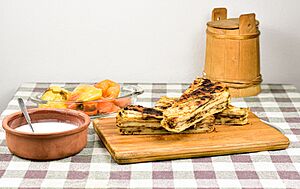
Kosovar cuisine is a mix of Balkan, Mediterranean, and Ottoman traditions. It also highlights its Albanian heritage. A very important part of the culture is hospitality.
Some popular dishes include Fli, a layered pastry baked slowly. Pite is a savory pie with meat, cheese, or spinach. Byrek is another flaky pastry. Qebapa are grilled sausages, often served with bread and ajvar. For dessert, Bakllavë and Trileçe are favorites.
Coffee is a big part of daily life in Kosovo. Sharing coffee is a way to connect with friends and family.
Sports Achievements
Kosovo has achieved a lot in international sports since 2008. It first participated in the Olympic Games in 2016 and won its first medals. Judo is a very successful sport for Kosovo. Majlinda Kelmendi won Kosovo's first Olympic gold medal in judo.
In 2016, Kosovo became a full member of Union of European Football Associations (UEFA) and Fédération Internationale de Football Association (FIFA). This allowed its national football team to compete in major football tournaments. Kosovo is also set to host the 2030 Mediterranean Games.
Images for kids
-
The "Heroinat" (Heroines) monument in Pristina, dedicated to women's strength and remembrance during difficult times.
-
US President Bill Clinton with Albanian children during his visit to Kosovo in June 1999.
-
The Newborn monument was unveiled during the celebration of Kosovo's declaration of independence on February 17, 2008, in Pristina.
-
prime minister of Kosovo]] Hashim Thaçi, then-U.S. Vice President Joe Biden, and the president of Kosovo Fatmir Sejdiu with the Declaration of Independence of Kosovo.
-
Majlinda Kelmendi, an Olympic, World, and European champion.
-
Bekim Fehmiu was the first Eastern European actor to star in Hollywood during the Cold War.
Related pages
See also
 In Spanish: Kosovo para niños
In Spanish: Kosovo para niños





